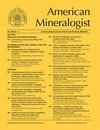In situ chemical and isotopic analyses and element mapping of multiple-generation pyrite: Evidence of episodic gold mobilization and deposition for the Qiucun epithermal gold deposit in Southeast China
IF 2.3
3区 地球科学
Q2 GEOCHEMISTRY & GEOPHYSICS
引用次数: 11
Abstract
Abstract Gold deposits are often the result of complex mineralization and remobilization processes. Interpretation of bulk geochemical and sulfur isotope data of the gold deposits is frequently hampered by complex zoning in pyrite, which calls for in situ determination of geochemical and sulfur isotope composition of sulfide minerals. The Qiucun deposit is a good representative of epithermal gold deposits in the Mesozoic Coastal Volcanic Belt of southeastern China. It represents a complex mineralization history, comprising three hydrothermal stages: (I) early stage of pyrite-quartz-chalcedony; (II) main ore stage of quartz-polymetallic sulfide; and (III) post-ore stage of quartz-carbonate. Detailed backscattered electron imaging (BSE) and in situ trace element and sulfur isotope analyses using laser ablation-inductively coupled plasma-mass spectrometry (LA-ICP-MS) and LA-multicollector (MC)-ICP-MS were applied to reveal the gold mineralization and remobilization history of this deposit. Four texturally distinct generations of pyrite were identified, all of which host invisible gold: Py1a and Py1b in Stage I and Py2a and Py2b in Stage II. A detailed study of the texture, chemistry, and sulfur isotopic composition as well as hydrothermal evolution of auriferous pyrite from the Qiucun deposit revealed the behavior of gold in the course of pyrite evolution. Pyrite of Stages I and II contains invisible gold, whereas later-stage visible native gold and re-enrichment in invisible gold is associated with alteration rims around the primary pyrite grains. Py1a is rich in silicate inclusions, enriched in Co and Ni, and depleted in As and Au relative to later pyrite generations. This redistribution is attributed to the alteration of biotite in the sub-volcanic host rocks that effectively destabilized gold in the ore fluid during Py1a deposition. Py1b and Py2a show oscillatory zoning with bright bands having elevated As and Au contents. The oscillatory zoning is interpreted to reflect pressure fluctuations and repeated local fluid boiling around the pyrite crystals. These three pyrite generations (Py1a, Py1b, Py2a) record a narrow range of δ34SV-CDT values between –3.6 and 4.6‰, consistent with a magmatic sulfur source. Gold and some trace elements (As, Ag, Sb, Pb, Tl, and Cu) that were initially incorporated into Py2a became partially exsolved and remobilized during the replacement of porous and invisible gold-rich Py2b. This replacement was likely due to coupled dissolution and re-precipitation reactions triggered by oxidation of the mineralizing fluids. Fluid oxidation is further supported by a general decrease trend of δ34SV-CDT from Py2a (–3.2 to 4.6‰) to Py2b (–15.2 to –2.3‰). Last, previously formed auriferous pyrite underwent post-mineralization fracturing, causing local pulverization of pyrite. Thus, newly created porosity facilitated fluid circulation, hydrothermal alteration of the pyrite, and remobilization of invisible gold, which re-precipitated with pyrite in the form of electrum as small inclusions or as larger grains within fractures. Our study emphasizes that pressure-driven hydrothermal processes play a vital role in the initial enrichment and re-concentration of gold and some other trace metals during episodic deposition, replacement, and hydrothermal alteration of gold-bearing pyrite in epithermal gold deposits, ultimately forming visible gold and high-grade ore shoots as exemplified by the Qiucun deposit.多代黄铁矿的原位化学和同位素分析及元素定位——中国东南邱村浅成低温热液金矿床幕式金矿活动和沉积的证据
摘要金矿床往往是复杂的矿化和再活化过程的结果。黄铁矿的复杂分带经常阻碍金矿床整体地球化学和硫同位素数据的解释,这需要原位测定硫化物矿物的地球化学和含硫同位素组成。邱村矿床是我国东南中生代滨海火山带浅成低温热液金矿床的典型代表。它代表了一个复杂的成矿历史,包括三个热液阶段:(I)黄铁矿-石英玉髓早期;(II) 石英多金属硫化物主成矿阶段;和(III)石英碳酸盐的后成矿阶段。采用激光烧蚀电感耦合等离子体质谱法(LA-ICP-MS)和LA多收集器(MC)-ICPMS进行详细的背散射电子成像(BSE)和原位微量元素和硫同位素分析,揭示了该矿床的金矿化和再活化历史。鉴定出四代结构不同的黄铁矿,它们都含有不可见的金:第一阶段的Py1a和Py1b,第二阶段的Py2a和Py2b。通过对邱村金矿含金黄铁矿的结构、化学、硫同位素组成及热液演化的详细研究,揭示了金在黄铁矿演化过程中的行为。阶段I和II的黄铁矿含有不可见金,而后期可见原生金和不可见金的再富集与原生黄铁矿颗粒周围的蚀变边缘有关。相对于后来的黄铁矿,Py1a富含硅酸盐包裹体,富含Co和Ni,贫含As和Au。这种重新分布归因于亚火山主岩中黑云母的蚀变,在Py1a沉积期间,黑云母有效地破坏了矿石流体中的金的稳定。Py1b和Py2a显示出振荡分带,亮带具有升高的As和Au含量。振荡分区被解释为反映了黄铁矿晶体周围的压力波动和重复的局部流体沸腾。这三代黄铁矿(Py1a、Py1b、Py2a)记录的δ34SV-CDT值范围很窄,在–3.6和4.6‰之间,与岩浆硫源一致。最初掺入Py2a的金和一些微量元素(As、Ag、Sb、Pb、Tl和Cu)在置换多孔和不可见的富金Py2b的过程中部分出溶和再活化。这种置换可能是由于矿化流体氧化引发的溶解和再沉淀反应的耦合。从Py2a(-3.2~4.6‰)到Py2b(-15.2~2.3‰),δ34SV-CDT的总体下降趋势进一步支持了流体氧化。最后,先前形成的含金黄铁矿发生矿化后破裂,导致黄铁矿局部粉碎。因此,新形成的孔隙促进了流体循环、黄铁矿的热液蚀变和不可见金的再活化,这些不可见金以小包裹体或裂缝内的大颗粒的形式与黄铁矿一起重新沉淀。我们的研究强调,在浅成热液金矿床中,在含金黄铁矿的幕式沉积、置换和热液蚀变过程中,压力驱动的热液过程在金和其他一些微量金属的初始富集和再富集中起着至关重要的作用,最终形成了可见的金和高品位的矿芽,以邱村矿床为例。
本文章由计算机程序翻译,如有差异,请以英文原文为准。
求助全文
约1分钟内获得全文
求助全文
来源期刊

American Mineralogist
地学-地球化学与地球物理
CiteScore
5.20
自引率
9.70%
发文量
276
审稿时长
1 months
期刊介绍:
American Mineralogist: Journal of Earth and Planetary Materials (Am Min), is the flagship journal of the Mineralogical Society of America (MSA), continuously published since 1916. Am Min is home to some of the most important advances in the Earth Sciences. Our mission is a continuance of this heritage: to provide readers with reports on original scientific research, both fundamental and applied, with far reaching implications and far ranging appeal. Topics of interest cover all aspects of planetary evolution, and biological and atmospheric processes mediated by solid-state phenomena. These include, but are not limited to, mineralogy and crystallography, high- and low-temperature geochemistry, petrology, geofluids, bio-geochemistry, bio-mineralogy, synthetic materials of relevance to the Earth and planetary sciences, and breakthroughs in analytical methods of any of the aforementioned.
 求助内容:
求助内容: 应助结果提醒方式:
应助结果提醒方式:


